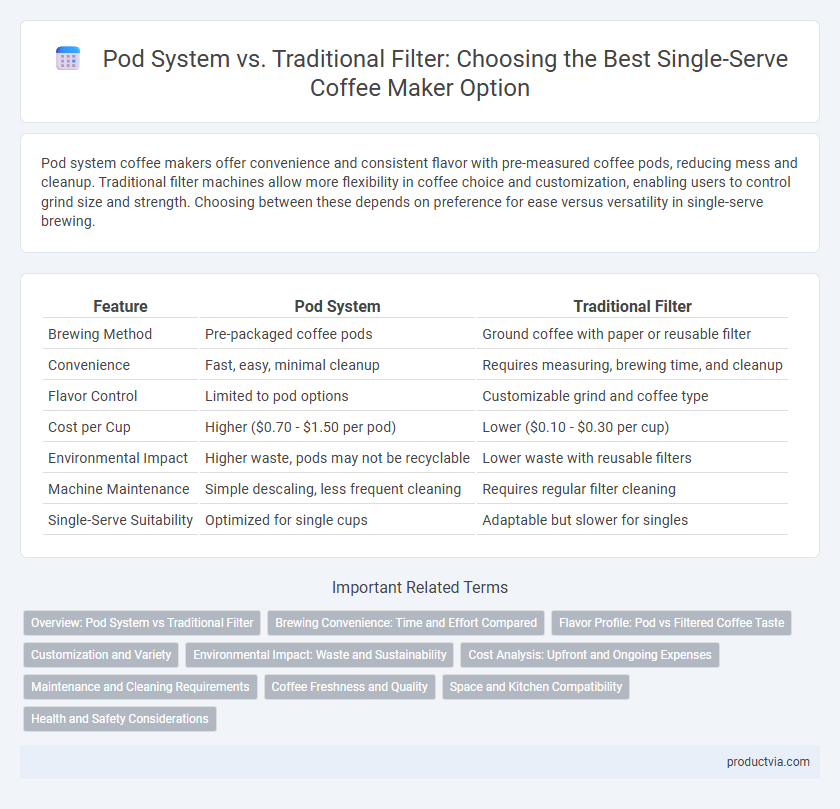Pod system coffee makers offer convenience and consistent flavor with pre-measured coffee pods, reducing mess and cleanup. Traditional filter machines allow more flexibility in coffee choice and customization, enabling users to control grind size and strength. Choosing between these depends on preference for ease versus versatility in single-serve brewing.
Table of Comparison
| Feature | Pod System | Traditional Filter |
|---|---|---|
| Brewing Method | Pre-packaged coffee pods | Ground coffee with paper or reusable filter |
| Convenience | Fast, easy, minimal cleanup | Requires measuring, brewing time, and cleanup |
| Flavor Control | Limited to pod options | Customizable grind and coffee type |
| Cost per Cup | Higher ($0.70 - $1.50 per pod) | Lower ($0.10 - $0.30 per cup) |
| Environmental Impact | Higher waste, pods may not be recyclable | Lower waste with reusable filters |
| Machine Maintenance | Simple descaling, less frequent cleaning | Requires regular filter cleaning |
| Single-Serve Suitability | Optimized for single cups | Adaptable but slower for singles |
Overview: Pod System vs Traditional Filter
Pod system coffee makers offer convenience and consistency by using pre-packaged coffee pods, ensuring quick single-serve brewing with minimal cleanup. Traditional filter machines allow customization of coffee strength and grind size, appealing to those who prefer control over flavor but require more time and effort for preparation and cleaning. Both systems cater to single-serve needs, with pods favoring speed and ease, while traditional filters emphasize versatility and cost-effectiveness.
Brewing Convenience: Time and Effort Compared
Pod system coffee makers deliver brewing convenience by offering a fast, mess-free experience, typically producing a single cup in under two minutes with minimal cleanup required. Traditional filter coffee machines for single-serve options involve grinding beans, measuring coffee, and dealing with filter disposal, which demands more time and effort overall. The pod system's pre-measured capsules optimize consistency and speed, making it ideal for busy users seeking quick, hassle-free coffee preparation.
Flavor Profile: Pod vs Filtered Coffee Taste
Pod system coffee offers a consistent flavor profile with precise extraction, preserving delicate aroma notes but sometimes resulting in a slightly muted or uniform taste. Traditional filter single-serve brewing allows more control over grind size and brewing time, producing a richer, more robust flavor with nuanced complexity and fuller body. Coffee enthusiasts who prioritize vibrant, layered profiles often prefer filtered coffee for its depth and authenticity compared to the convenience-driven pod system.
Customization and Variety
Pod system coffee makers offer a wide range of flavors and brew strengths, allowing users to easily customize each cup with pre-measured pods designed for consistency and convenience. Traditional filter coffee makers provide greater flexibility in selecting coffee bean types, grind size, and brewing time, catering to enthusiasts seeking personalized flavor profiles. Both methods support single-serve options, but pod systems emphasize convenience and variety, while traditional filters prioritize customization and freshness.
Environmental Impact: Waste and Sustainability
Pod coffee makers generate significant waste due to single-use plastic or aluminum pods that contribute to landfill overflow and environmental pollution. Traditional filter systems use reusable components like permanent filters or biodegradable paper filters, significantly reducing waste and promoting sustainability. Choosing a traditional filter option supports eco-friendly coffee brewing by minimizing disposable materials and encouraging compostable byproducts.
Cost Analysis: Upfront and Ongoing Expenses
Pod systems demand higher upfront costs for the coffee maker, typically ranging from $100 to $200, while traditional filter machines can be found for as low as $30 to $80. Ongoing expenses for pods are significantly higher, averaging around $0.70 to $1.00 per serving, compared to approximately $0.10 to $0.30 per cup with ground coffee in filter systems. Evaluating long-term cost efficiency, traditional filter coffee makers offer more economical brewing, especially for frequent single-serve consumption.
Maintenance and Cleaning Requirements
Pod system coffee makers require minimal maintenance, with most components being easy to rinse or replace regularly, while their pods create less mess compared to loose grounds. Traditional filter machines demand frequent cleaning of the filter basket, carafe, and drip area to prevent buildup of coffee oils and sediment, which can affect taste and machine performance. Both systems benefit from regular descaling to remove mineral deposits and ensure optimal function, but pod machines often streamline the cleaning process due to their self-contained brewing pods.
Coffee Freshness and Quality
Pod system coffee makers maintain consistent coffee freshness by sealing pre-ground coffee in airtight pods, which preserves aroma and flavor for each single-serve brew. Traditional filter machines rely on freshly ground beans that can lose quality quickly once exposed to air, resulting in diminished taste over time if not brewed immediately. While pod systems offer convenience and uniform quality, traditional filters provide more control over coffee grind size and bean origin, impacting overall freshness and flavor intensity.
Space and Kitchen Compatibility
Pod system coffee makers offer compact designs that save countertop space and fit well in small kitchens or apartments. Traditional filter machines, often bulkier due to larger water reservoirs and carafes, may occupy more space but provide flexibility with ground coffee. Consumers with limited kitchen space typically prefer pod systems for their sleek profiles and minimal storage requirements.
Health and Safety Considerations
Pod system coffee makers often use pre-packaged pods that may contain plastic or aluminum, raising concerns about potential chemical leaching and environmental waste, while traditional filter methods use ground coffee with minimal material contamination risk. Traditional filters allow control over coffee freshness and reduce exposure to additives or preservatives sometimes found in pods, promoting a more natural and healthier brewing experience. Both methods require proper cleaning to prevent mold and bacteria buildup, but pod systems generally involve less frequent cleaning, which might increase contamination risks if neglected.
Pod system vs Traditional filter for single-serve options Infographic

 productvia.com
productvia.com